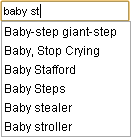In computing, a namespace is a set of signs (names) that are used to identify and refer to objects of various kinds. A namespace ensures that all of a given set of objects have unique names so that they can be easily identified.

Extensible Markup Language (XML) is a markup language and file format for storing, transmitting, and reconstructing arbitrary data. It defines a set of rules for encoding documents in a format that is both human-readable and machine-readable. The World Wide Web Consortium's XML 1.0 Specification of 1998 and several other related specifications—all of them free open standards—define XML.
Jakarta Server Pages is a collection of technologies that helps software developers create dynamically generated web pages based on HTML, XML, SOAP, or other document types. Released in 1999 by Sun Microsystems, JSP is similar to PHP and ASP, but uses the Java programming language.
AspectJ is an aspect-oriented programming (AOP) extension for the Java programming language, created at PARC. It is available in Eclipse Foundation open-source projects, both stand-alone and integrated into Eclipse. AspectJ has become a widely used de facto standard for AOP by emphasizing simplicity and usability for end users. It uses Java-like syntax, and included IDE integrations for displaying crosscutting structure since its initial public release in 2001.
In computer science, reflective programming or reflection is the ability of a process to examine, introspect, and modify its own structure and behavior.
In computing, type introspection is the ability of a program to examine the type or properties of an object at runtime. Some programming languages possess this capability.

Apache Groovy is a Java-syntax-compatible object-oriented programming language for the Java platform. It is both a static and dynamic language with features similar to those of Python, Ruby, and Smalltalk. It can be used as both a programming language and a scripting language for the Java Platform, is compiled to Java virtual machine (JVM) bytecode, and interoperates seamlessly with other Java code and libraries. Groovy uses a curly-bracket syntax similar to Java's. Groovy supports closures, multiline strings, and expressions embedded in strings. Much of Groovy's power lies in its AST transformations, triggered through annotations.

ActionScript is an object-oriented programming language originally developed by Macromedia Inc.. It is influenced by HyperTalk, the scripting language for HyperCard. It is now an implementation of ECMAScript, though it originally arose as a sibling, both being influenced by HyperTalk. ActionScript code is usually converted to byte-code format by a compiler.
Code completion is an autocompletion feature in many integrated development environments (IDEs) that speeds up the process of coding applications by fixing common mistakes and suggesting lines of code. This usually happens through popups while typing, querying parameters of functions, and query hints related to syntax errors. Modern code completion software typically uses generative artificial intelligence systems to predict lines of code. Code completion and related tools serve as documentation and disambiguation for variable names, functions, and methods, using static analysis.

Autocomplete, or word completion, is a feature in which an application predicts the rest of a word a user is typing. In Android and iOS smartphones, this is called predictive text. In graphical user interfaces, users can typically press the tab key to accept a suggestion or the down arrow key to accept one of several.

jEdit is a free software text editor available under GPL-2.0-or-later. It is written in Java and runs on any operating system with Java support, including BSD, Linux, macOS and Windows.
In computer programming, a naming convention is a set of rules for choosing the character sequence to be used for identifiers which denote variables, types, functions, and other entities in source code and documentation.
Embedded Ruby is a templating system that embeds Ruby into a text document. It is often used to embed Ruby code in an HTML document, similar to ASP and JSP, and PHP and other server-side scripting languages. The templating system of eRuby combines Ruby code and plain text to provide flow control and variable substitution, thus making the combined code easier to maintain.
this, self, and Me are keywords used in some computer programming languages to refer to the object, class, or other entity which the currently running code is a part of. The entity referred to thus depends on the execution context. Different programming languages use these keywords in slightly different ways. In languages where a keyword like "this" is mandatory, the keyword is the only way to access data and methods stored in the current object. Where optional, these keywords can disambiguate variables and functions with the same name.
C# and Visual Basic .NET are the two primary languages used to program on the .NET Framework.
TypeScript is a free and open-source high-level programming language developed by Microsoft that adds static typing with optional type annotations to JavaScript. It is designed for the development of large applications and transpiles to JavaScript. Because TypeScript is a superset of JavaScript, all JavaScript programs are syntactically valid TypeScript, but they can fail to type-check for safety reasons.
The Template Attribute Language (TAL) is a templating language used to generate dynamic HTML and XML pages. Its main goal is to simplify the collaboration between programmers and designers. This is achieved by embedding TAL statements inside valid HTML tags which can then be worked on using common design tools.
In computer science, marshalling or marshaling is the process of transforming the memory representation of an object into a data format suitable for storage or transmission, especially between different runtimes. It is typically used when data must be moved between different parts of a computer program or from one program to another.
Web2py is an open-source web application framework written in the Python programming language. Web2py allows web developers to program dynamic web content using Python. Web2py is designed to help reduce tedious web development tasks, such as developing web forms from scratch, although a web developer may build a form from scratch if required.



